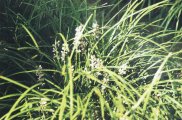Ophipogon Root
http://www.100md.com
《e Natural Health Center》
 |
 |
 |
Yin Tonics
Ophipogon Root
Latin:
Radix Ophiopogonis
Origin:
The dry root tuber of the perennial herbaceous plant Ophiopogon japonicus (Thunb.) Ker-Gawl., of the family Liliaceae. Native to east Asia, the plant is grown on damp ground, in shady places and in lowland in Japan, China and Southeast Asian countries. The scientific name of the plant is derived from ophis, which means "snake," and pogon, which means "beard," most probably referring to the flower spike.
, 百拇医药
The perennial plant is tufted, grasslike, and grows to about 0.3 m by 1 m. The leaves are dark green and fine to medium in texture. They are erect to arching, smooth and grasslike. The flowers are usually white or white tinged with lilac. The fruits are blue. The plant is in leaf all year, in flower in August. The flowers are hermaphrodite (have both male and female organs). The plant can grow in semi-shade (light woodland) or no shade. It requires moist or wet soil and can grow in water.
, 百拇医药
Ophipogon is primarily used as groundcover. It is also attractive as a border along paths, between stepping stones or flowerbed and lawn, or in rock gardens. It grows well along streams and around garden ponds. Under trees or shrubs it makes an excellent shade-tolerant lawn that never needs mowing.
In China, ophipogon root is used as a yin tonic. Rarely cultivated, the wild plant is distributed in many areas of China, but mainly in Zhejiang, Sichuan and Hubei provinces. The root is dug and collected in spring, cleaned, cleared of hairy rootlets and dried in the sun for use.
, http://www.100md.com
Also called Snake's Beard Root, Creeping Lily-turf Root, Mondo Grass Root or Monkey Grass Root.
Properties:
Sweet and slightly bitter in flavor, slightly cold in nature, it is related to the heart, stomach and lung channels.
Functions:
Nourishes yin, moistens the lung, tonifys the stomach, promotes the production of the body fluid, dispels heat from the heart and relieves vexation.
, 百拇医药
Applications:
1. To treat dry cough with little sputum due to impairment of the lung caused by dry heat, the herb is often used in combination with sha shen, mulberry leaf, gypsum and other herbs for clearing heat from the lung to moisten dryness.
2. The herb is often used in combination with ginseng and achisandra fruit for invigorating qi and nourishing yin, such as Shengmai Powder, to treat vexation, thirst, perspiration and lassitude due to impairment of qi and yin caused by febrile disease; and with dried rehmannia root, sha shen, solomon's seal rhizome and other herbs for nourishing yin and promoting the generation of the body fluid, to treat dry mouth and thirst due to deficiency of the stomach-yin, or diabetes due to internal heat.
, 百拇医药
3. To treat vexation, dry mouth, insomnia, dreaminess and red tongue with little fur due to yin deficiency of the lung and kidney, the herb is often used in combination with dried rehmannia root, scrophularia root, Chinese angelica root, wild or spiny jujube seed and other herbs for nourishing yin, moistening dryness, tonifying the heart and tranquilizing the mind.
Dosage and Administration:
10-15 g.
, http://www.100md.com
Decoction.
Cautions on Use:
Reference Materials:
Toxic or Side Effects:
Modern Researches:
Ophiopogon root can enhance phagocytosis (engulfs and consumes microorganisms by phagocyte, the white blood cells) of the reticuloendothelial system, increase peripheral leukocytes, enhance the immunity and adaptability of the body, improve the function of pituitary-adrenocortical axis, reduce blood sugar, strengthen the heart and dilate peripheral blood vessels.
, http://www.100md.com
The herb has an inhibiting effect on Staphylococcus albus, hay bacillus, E. coli, Bacillus subtilis, Bacillus coli and typhoid bacillus in vitro. Ophiopogon root injection can obviously enhance in mice the resistance to hypoxia (a deficiency of oxygen reaching the tissues of the body).
It is reported in 'Medicinal Plants of China,' (Reference Publications, Inc., 1985) that ophiopogon root has anticancer activity. It is also frequently used in polyherbal treatments of diabetes mellitus.
The plant is antipyretic (reduces fever), antiscrophulatic, antitussive (cough suppressant), emollient (soothing), expectorant (promoting the ejection, by spitting, of mucus or other fluids from the lungs and trachea) and tonic.
Nodules on the fibrous roots are used as a nutritive tonic in the treatment of tuberculosis., http://www.100md.com